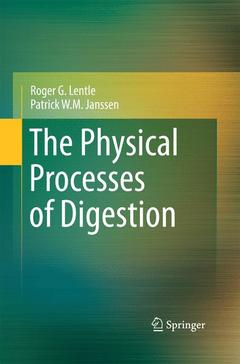Description
The Physical Processes of Digestion, 2011
Authors: Lentle Roger G., Janssen Patrick W.M.
Language: English
Subjects for The Physical Processes of Digestion:
Approximative price 105.49 €
In Print (Delivery period: 15 days).
Add to cartPublication date: 11-2014
279 p. · 15.5x23.5 cm · Paperback
Approximative price 105.49 €
In Print (Delivery period: 15 days).
Add to cartPublication date: 06-2011
279 p. · 15.5x23.5 cm · Hardback
Description
/li>Contents
/li>Biography
/li>Comment
/li>
Food research (and funding) is becoming more and more focused on health. While researchers and product developers have made great strides in food engineering, there needs to be increased focus on what happens when the food is actually digested. How is the food absorbed? Do the benefits remain? Digestion is a complex topic, and this will be the first book aimed at food researchers. Authored by a physiologist and a food engineer, the book will be a welcome addition to the literature.
Introduction
Flow mixing and absorption. The physical problems of extracting nutrients from food items and the possible macroscopic and microscopic solutions. The digestive tube and its limitations. solid to liquid to solid
Methods for evaluating the physical properties of digesta
Particle size
Rheology Viscometry Viscoelastic behaviour Time dependent behaviour
Permeametry
Hindered settling function
Permeability and other measures
Methods for evaluating the relationship between motility and flow of digesta
Solid and liquid phase markers
Reactor mixing
Spatiotemporal mapping
Physical behaviour of fluid digesta
Macroscopic effects Newtonian and non Newtonian behaviour of fluids. Where digesta fit in this system the kinetics of digesta flow Securing efficient absorption from fluids and non-Newtonian fluids, chemical reactor theory and problems
Buoyancy
Backflow form coiled elements
Physical behaviour of solid digesta
The continuum between solids and liquids viscoselasticity securing efficient absorption from fluids and from viscoelastic fluids
Permeability extrusion of the liquid phase
Propulsion and mixing of digesta the interplay between the gut wall and its contents
Tension and stretch receptors in the enteric nervous system
Maintaining the flow of digesta problems of narrowing and expanding
Co-evolution of motility and the physical properties of digesta
Micromixing
Diffusion. Mucus and the unstirred water layer.
Flow in the paravillus space and the crypts.
Tight junctions permeability and fluid flow
Glycocalyceal signalling of shear
The physics of food
What is known about how the physical structure of food interacts with the digestive processes e.g starch granule digestion digestion of proteinaceous aggregates eetc ( Dr Allan Hardacre NZ Crop and Food )
Flow and microorganisms
Adaptions of micro-organisms to move within digesta and mucus
Glycocalyceal signalling
Messing with the properties of digesta
Adulterating foods with viscoactive substances
Nutraceuticals planning the rate of nutrient release. Modulating lumen pressure
Microencapsulation and adherence to the gut wall
<b>Roger Lentle</b> graduated in medicine and in biochemistry from University College London and gained his PhD at Massey University, New Zealand. He has published extensively on the physical processes of digestion and is Professor of Digestive Biomechanics at the Institute of Food Nutrition and Human Health at Massey University.<P>
<b>Patrick Janssen</b> gained his PhD in chemical and process engineering at Canterbury University, New Zealand. He worked in the fields of process control and milk fat processing in the dairy industry before developing an interest in the physical processes of digestion. Currently he is a senior lecturer at the Institute of Food Nutrition and Human Health at Massey University.
Thorough overview of the current state of knowledge regarding the physical processing of food and nutrients within the gastrointestinal tract
An examination of the biological factors that influence mixing and absorption of nutrients
Several chapters contributed by recognized experts




